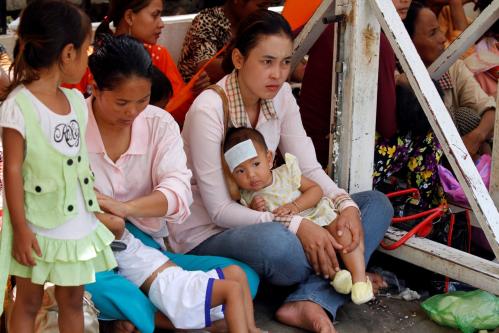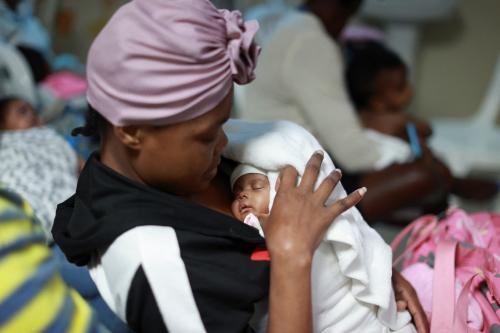When we think about health care in low and middle-income countries, we think about vaccines, controlling epidemics of major infectious diseases, and perhaps improving nutrition and sanitation.
There is a good reason these interventions come to mind: over the past few decades they have saved literally millions of lives. But it’s easy to forget that people in poor countries also get into car accidents. They get pneumonia, heart attacks, diarrheal illnesses, and asthma too.
Not all these emergencies are preventable—even in high-income countries that have been investing in prevention and primary care for decades. So it’s no surprise that studies consistently put emergency conditions at the top of the list of causes of death and disability worldwide.
Findings from a recent study reinforce the idea that emergency care, far from a “luxury item,” is in fact a core, urgent issue for patients and health systems in low and middle-income countries (LMICs). Working with collaborators from South Africa to Pakistan, our group, the Acute Care Development Consortium, reviewed over 40,000 published and unpublished reports to generate a snapshot of emergency care in LMICs.
A back-of-the-envelope calculation for a country like Nigeria can give a sense of our findings. Applying our estimates to the country’s 1,000 or so major hospitals, we find that fully 10-15 percent of all deaths occurred in emergency facilities. And unlike high-income countries, where emergency facilities serve growing numbers of chronically ill elders, these patients are young, healthy, and economically productive.
The volume of patients seeking emergency care in LMICs is enormous; facilities see on average 10 times the caseloads of primary care doctors in similar settings. And mortality rates are staggering—multiples of those in high-income countries, especially in pediatric facilities in central Africa. In some facilities, up to one in five children brought in for treatment die in the emergency setting, in front of a provider.
Given these numbers, emergency care in LMICs seems shockingly under-resourced. Most providers working in the facilities we studied have no specific training in emergency care. Conditions are often heartbreakingly rudimentary. In one pediatric facility in Benin in West Africa, over 80 percent of all children were evaluated, treated, and released from a 4-by-0.5 meter wooden board set up in the patient intake area. Funding for emergency care is almost nonexistent, and the issue is absent from agendas of most donors and international organizations.
But with so many competing priorities in global health, most of them under-resourced, what makes emergency care different?
A key insight comes from the evolution of emergency care in high-income countries. Over the past few decades, focused efforts to improve quality—advances in clinical operations, protocolized care, provider training, and more—have translated into major reductions in mortality across several diseases and conditions. And for all the hand-wringing in policy circles about overuse, emergency care accounts for a tiny fraction of national medical expenditures. It is a small price to pay for lives saved.
Encouragingly, we found early indications from LMICs that similar improvements in emergency care—better triage, improved patient flow, supervision of junior providers—can also lead to dramatic reductions in mortality. These interventions did not require massive new investments in infrastructure; they simply tweaked the way existing health system resources are used, meaning that lives, limbs, and discomfort were likely saved at very little cost.
So it’s inevitable to wonder: should emergency care have a more prominent position in the broader “Health for All” agenda, which has invested heavily—and nearly exclusively—on traditional primary care? The answer to this question must be grounded in data and analysis, not tradition and ideology.
It’s important to remember that primary and emergency care are far from incompatible: both seek to provide integrated platforms for care delivery across disease areas; and indeed, in most LMICs, infrastructure designed for primary care is strained to the breaking point, in part by patients seeking emergency care in so-called “outpatient departments.”
But to better understand the place of emergency care in the global health agenda, we need more evidence on interventions that work in the emergency setting in LMICs. We need to know more about costs, effectiveness, numbers needed to treat, and other metrics, so we can allocate resources appropriately. We also need to understand areas of complementarity—in infrastructure, training, and other aspects of care delivery—between emergency care, primary care, and other areas like maternal health, with overlapping infrastructure and human resource needs.
There is no question that disease and injury prevention are core functions of health systems everywhere. But parallel investments in emergency care could help promote innovative cost-effective interventions, break down disease-specific silos in health care delivery, and prepare us for the next epidemic of Ebola—or something worse. So, in a way, rethinking emergency care might actually get us closer to the original Alma Ata goals of primary care and health for all.
The Brookings Institution is committed to quality, independence, and impact.
We are supported by a diverse array of funders. In line with our values and policies, each Brookings publication represents the sole views of its author(s).




Commentary
Rethinking emergency care is a key part of ‘Health for All’
August 25, 2015